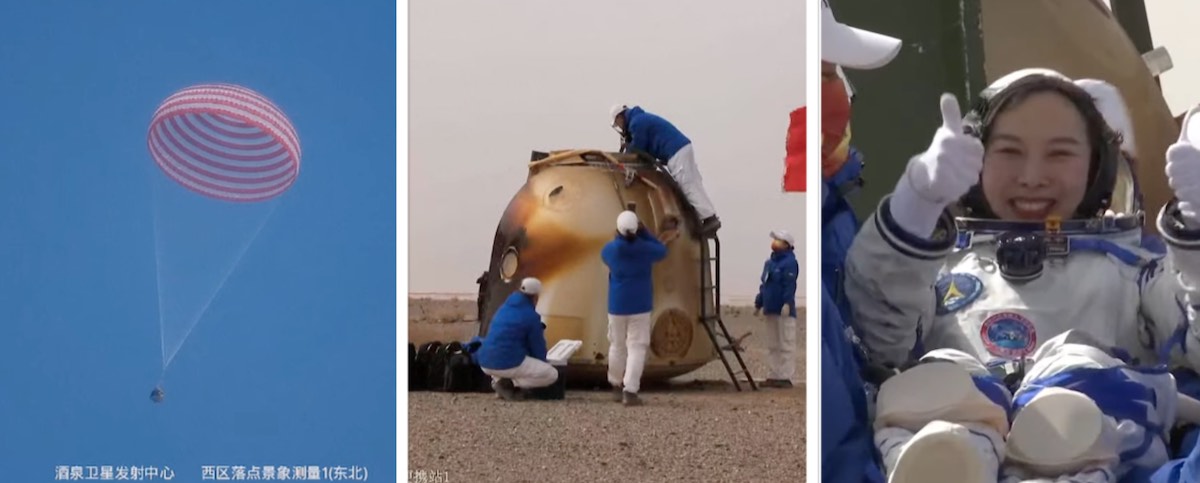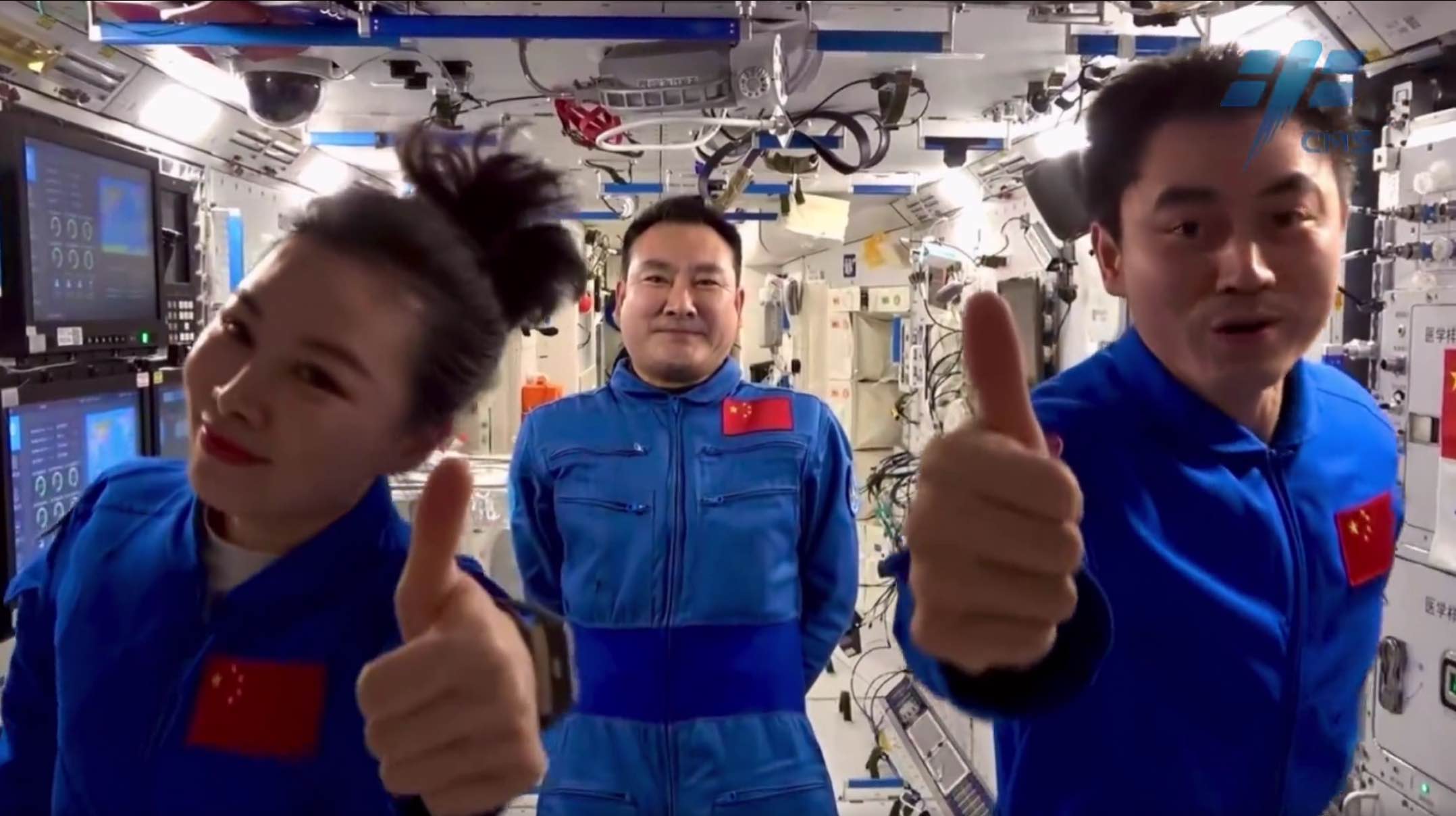
Three Chinese astronauts flew back to Earth late Friday to wrap up a 182-day mission on China’s space station, the longest crew mission in the history of the country’s space program. The landing sets the stage for launch of a new crew and expansion of the Chinese space station later this year.
Suspended under a parachute, the Shenzhou 13 spacecraft landed in the Inner Mongolia region of northwestern China at 9:56 p.m. EDT Friday (0156 GMT Saturday), bringing home commander Zhai Zhigang and crewmates Wang Yaping and Ye Guangfu.
The Shenzhou 13 flight lasted about twice as long as the longest previous Chinese human spaceflight mission. Wang, a 42-year-old former Chinese military pilot, became the Chinese astronaut with the most time spent in space: 197 days over two missions.
“We have successfully completed the mission of Shenzhou 13,” Zhai said in an interview with Chinese state television after the landing. “We are now back on Earth.”
All three crew members reported they were healthy after landing. The astronauts thanked the Chinese government and Chinese people for their support before ground teams helped them into support vehicles for medical checks.
Wang had a message for her 6-year-old daughter: “I’m back with all the stars I collected for you.”
An infrared tracking camera near the landing site in the Inner Mongolia region has sighted China’s Shenzhou 13 entry capsule streaking back into the atmosphere after six months in orbit.
Astronauts Zhai Zhigang, Wang Yaping, and Ye Guangfu are on-board.https://t.co/tO69l0zrpz pic.twitter.com/h1490U3PbH
— Spaceflight Now (@SpaceflightNow) April 16, 2022
The three astronauts launched Oct. 15 on the Shenzhou 13 spacecraft, and docked with the Chinese space station’s Tianhe core module six-and-a-half hours later.
After six months performing experiments, spacewalks, and preparing the station for future expansion, the Shenzhou 13 astronauts floated into their Shenzhou 13 spacecraft and closed hatches with the Tianhe core module Friday. The spacecraft undocked from the station’s nadir, or Earth-facing, port at 12:44 p.m. EDT (1644 GMT) while the lab soared nearly 240 miles (380 kilometers) above the planet, according the China Manned Space Agency.
The spacecraft fired thrusters to move a safe distance from the space station, then jettisoned its orbital habitation module, which will remain in orbit until aerodynamic drag pulls it back into the atmosphere. The ship’s engines then ignited for a deorbit burn to slow down for re-entry, then Shenzhou’s propulsion module separated, leaving the landing capsule to bring the three astronauts back to Earth.
The re-entry capsule, protected by a heat shield, encountered temperatures of several thousands degrees. After a brief build-up in G forces, the spacecraft deployed a main parachute to slow its descent for touchdown at the Dongfeng landing site in the Inner Mongolia region of northwestern China.
The Shenzhou 13 spacecraft has survived its super-hot atmospheric re-entry and deployed a main parachute to slow down for landing.
Everything appears to be going well with the crew return from the Chinese space station.
Watch live: https://t.co/tO69l0zrpz pic.twitter.com/JSbTKEX8hH
— Spaceflight Now (@SpaceflightNow) April 16, 2022
The Dongfeng landing field is near the Jiuquan launch center, where Shenzhou 13 blasted off last October. The previous Shenzhou mission, which returned to Earth last September, became the first mission to land with astronauts at the Dongfeng site. Earlier Chinese missions parachuted into a different part of Inner Mongolia known as Siziwang Banner.
During their stay on the Chinese space station, the Shenzhou 13 astronauts completed a series of experiments and performed two spacewalks.
Zhai and Wang completed the mission’s first spacewalk Nov. 7. The astronauts prepared the space station’s 47-foot (14.5-meter) robotic arm for service, connecting its two main segments and installing a suspension device to help the arm move equipment around the exterior of the laboratory.
Wang became the first Chinese woman to perform a spacewalk.
The mission’s second spacewalk on Dec. 26 was performed by Ye and Zhai, who deployed an external panoramic camera and tested methods for astronauts on future missions to move objects around the outside of the station.
Both spacewalks lasted more than six hours, and the astronauts wore Chinese-made Feitian space suits.
The Shenzhou 13 astronauts also evaluated the living and working conditions inside the Tianhe core module. They proved out the station’s life support system, which includes technology to recycle urine, sweat, and water vapor into drinking water. The astronauts also tested the station’s stationary bicycle and treadmill to maintain physical fitness during their mission.
Touchdown! Chinese astronauts Zhai Zhigang, Wang Yaping, and Ye Guangfu are back on Earth after 182 days in orbit, setting a new record for the longest-duration spaceflight by Chinese astronauts to date. https://t.co/tO69l0zrpz pic.twitter.com/H0vI4UIx97
— Spaceflight Now (@SpaceflightNow) April 16, 2022
The astronauts spoke to the Chinese public in science education and outreach activities, and celebrated traditional events on the Chinese calendar, such as the Chinese New Year, or Spring Festival, and the Lantern Festival. Wang, who is on her second mission to space, said the astronauts enjoyed Chinese cuisine on the station, including dumplings, zongzi, mooncakes, and tangyuan.
The Chinese astronauts answered questions from U.S. schoolchildren April 9 in an event hosted by the Chinese Embassy in Washington. Wang said then she was looking forward to returning to Earth, seeing her daughter and running outside on sunny afternoons.
“We have carried out experiments in the space station to study how cell growth and development change under weightless conditions and investigated their variation patterns and mechanisms,” Ye told the U.S. students.
Zhai Zhigang is a 55-year-old major general in the People’s Liberation Army Strategic Support Force. Shenzhou 13 was Zhai’s second space mission. He became the first Chinese astronaut to perform a spacewalk in 2008.
Ye, 41, wrapped up his first mission to space. Like his crewmates, he was a pilot in the Chinese military before joining the country’s astronaut corps.
The Shenzhou 13 mission was the second crew to live and work on the Chinese space station, following the 92-day Shenzhou 12 mission last year. The Shenzhou 13 astronauts nearly doubled the Chinese spaceflight endurance record set by Shenzhou 12.

The departure of the Shenzhou 13 crew leaves the Chinese space station unoccupied until the launch of the next long-duration team of astronauts in June. Shenzhou 14 will deliver three more astronauts to the station for another six-month mission.
The first section of the Chinese space station, Tianhe, launched last April on a heavy-lift Long March 5 rocket. The Tianzhou 2 cargo ship launched in May, followed by the Shenzhou 12 launch in June, and the Tianzhou 3 supply mission in September.
The Tianzhou 2 supply ship undocked from the station last month and burned up during re-entry, as designed. China plans to launch the Tianzhou 4 cargo mission in May, then Shenzhou 14 is scheduled to lift off in June.
Later this year, China plans to launch the large Wentian and Mengtian laboratory modules to complete the initial assembly of the space station.
Email the author.
Follow Stephen Clark on Twitter: @StephenClark1.
from Spaceflight Now https://ift.tt/SlrQM3f
via World Space Info







0 comments:
Post a Comment